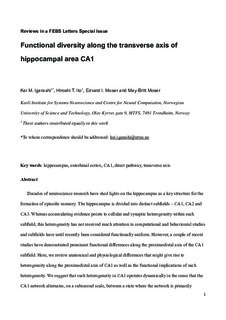| dc.contributor.author | Igarashi, Kei M | |
| dc.contributor.author | Ito, Hiroshi | |
| dc.contributor.author | Moser, Edvard Ingjald | |
| dc.contributor.author | Moser, May-Britt | |
| dc.date.accessioned | 2017-12-14T09:55:08Z | |
| dc.date.available | 2017-12-14T09:55:08Z | |
| dc.date.created | 2014-06-16T23:02:16Z | |
| dc.date.issued | 2014 | |
| dc.identifier.citation | FEBS Letters. 2014, 588 (15), 2470-2476. | nb_NO |
| dc.identifier.issn | 0014-5793 | |
| dc.identifier.uri | http://hdl.handle.net/11250/2471615 | |
| dc.description.abstract | Decades of neuroscience research have shed lights on the hippocampus as a key structure for the formation of episodic memory. The hippocampus is divided into distinct subfields – CA1, CA2 and CA3. Whereas accumulating evidence points to cellular and synaptic heterogeneity within each subfield, this heterogeneity has not received much attention in computational and behavioural studies and subfields have until recently been considered functionally uniform. However, a couple of recent studies have demonstrated prominent functional differences along the proximodistal axis of the CA1 subfield. Here, we review anatomical and physiological differences that might give rise to heterogeneity along the proximodistal axis of CA1 as well as the functional implications of such heterogeneity. We suggest that such heterogeneity in CA1 operates dynamically in the sense that the CA1 network alternates, on a subsecond scale, between a state where the network is primarily responsive to functionally segregated direct inputs from entorhinal cortex and a state where cells predominantly are controlled by more integrated inputs from CA3. | nb_NO |
| dc.language.iso | eng | nb_NO |
| dc.publisher | Elsevier | nb_NO |
| dc.rights | Attribution-NonCommercial-NoDerivatives 4.0 Internasjonal | * |
| dc.rights.uri | http://creativecommons.org/licenses/by-nc-nd/4.0/deed.no | * |
| dc.title | Functional diversity along the transverse axis of hippocampal area CA1 | nb_NO |
| dc.type | Journal article | nb_NO |
| dc.type | Peer reviewed | nb_NO |
| dc.description.version | acceptedVersion | nb_NO |
| dc.source.pagenumber | 2470-2476 | nb_NO |
| dc.source.volume | 588 | nb_NO |
| dc.source.journal | FEBS Letters | nb_NO |
| dc.source.issue | 15 | nb_NO |
| dc.identifier.doi | 10.1016/j.febslet.2014.06.004 | |
| dc.identifier.cristin | 1138395 | |
| dc.relation.project | Norges forskningsråd: 223262 | nb_NO |
| dc.relation.project | EU/268598 | nb_NO |
| dc.relation.project | Andre: Kavli Foundation | nb_NO |
| dc.description.localcode | © 2014 Federation of European Biochemical Societies. Published by Elsevier B.V. All rights reserved.This is the authors’ accepted and refereed manuscript to the article. This manuscript version is made available under the CC-BY-NC-ND 4.0 license http://creativecommons.org/licenses/by-nc-nd/4.0/ | nb_NO |
| cristin.unitcode | 194,65,60,0 | |
| cristin.unitname | Kavliinstitutt for nevrovitenskap | |
| cristin.ispublished | true | |
| cristin.fulltext | postprint | |
| cristin.qualitycode | 1 | |

